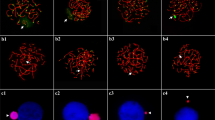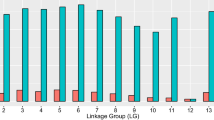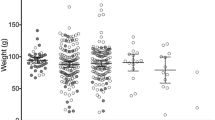Abstract
We report the identification of a single major chromosomal region controlling natural killer (NK) cell-like activity in rainbow trout (Oncorhynchus mykiss). A genetic map based on 484 AFLP and 39 microsatellite genotypes from 106 doubled haploid fish was constructed. These fish were produced by androgenesis from a hybrid of two clonal lines divergent in NK-like activity. NK-like activities for 75 of the doubled haploids were quantified by an in vitro chromium release assay utilizing 51Cr-labeled YAC-1 target cells. Composite interval mapping revealed a single major quantitative trait locus (QTL) associated with NK-like activity in this rainbow trout model. Genetic mapping revealed this QTL to also be unlinked to: fragmented MHC class I and MHC class II regions, the leukocyte receptor cluster, the natural killer cell enhancement factor (NKEF) gene, the RAG-1 gene, and two QTL associated with resistance to infectious pancreatic necrosis virus in rainbow trout. Collectively, these results extend the utility of rainbow trout as an immunological model and are consistent with the idea that a single chromosomal region homologous to the natural killer cell complex (NKC) located on syntenic portions of mouse chromosome (Chr) 6, human Chr 12, and rat Chr 4 may exist in a lower vertebrate model.




Similar content being viewed by others
References
Allendorf F, Thorgaard G (1984) Tetraploidy and the evolution of salmonid fishes. In: Turner BJ (ed) Evolutionary genetics of fishes. Plenum, New York, pp 1–46
Berstein R, Schluter S, Marchalonis J (1997) Immunity. In: Evans DH (ed) The physiology of fishes. CRC, London, pp 215–242
Borrego F, Ulbrecht M, Weiss E, Coligan J, Brooks A (1998) Recognition of human histocompatibility leukocyte antigen HLA-E complexed with HLA class I signal sequence-derived peptides by CD94/NKG2 confers protection from natural killer cell mediated lysis. J Exp Med 187:813–818
Boyington J, Brooks A, Sun P (2001) Structure of killer cell immunoglobulin-like receptors and their recognition of the class I MHC molecules. Immunol Rev 181:66–78
Braud V, Allan D, O’Callaghan C, Soderstrom K, Phillips J, Lanier L, McMichael A (1998) HLA-E binds to natural killer cell receptors CD94/NKG2A, B and C. Nature 391:795–799
Brown M, Dokun A, Heusel J, Smith H, Beckman D, Blattenberger E, Dubbelde C, Stone L, Scalzo A, Yokoyama W (2001) Vital involvement of a natural killer cell activation receptor in resistance to viral infection. Science 292:934–937
Carbonell E, Asins J, Baselga M, Balansard E, Gerig T (1993) Power studies in the estimation of genetic parameters and the localization of quantitative trait loci for backcross and doubled haploid populations. Theor Appl Genet 86:411–416
Cerwenka A, Lanier L (2001) Ligands for natural killer cell receptors: redundancy or specificity. Immunol Rev 181:158–169
Churchill G, Doerge R (1994) Empirical threshold values for quantitative trait mapping. Genetics 138:963–971
Cleland G, Sonstegard R (1987) Natural killer cell activity in rainbow trout: effect of dietary exposure to aroclor 1254 and mirex. Can J Fish Aquat Sci 44:636–638
Diefenbach A, Raulet D (2001) Strategies for target cell recognition by natural killer cells. Immunol Rev 181:170–184
Dissen E, Ryan J, Seaman W, Fossum S (1996) An autosomal dominant locus, Nka mapping to the Ly-49 region of a rat natural killer (NK) gene complex controls NK cell lysis of allogeneic lymphocytes. J Exp Med 183:2197–2207
Evans D, Hogan K, Graves S, Carlson R, Floyd E, Dawe D (1984) Nonspecific cytotoxic cells in fish (Ictalurus punctatus). Dev Comp Immunol 8:599–610
Faisal M, Ahmed I, Peters G, Cooper E (1989) Natural cytotoxicity of tilapia leukocytes. Dis Aquatic Org 7:17–22
Fischer U, Utke K, Ototake M, Diskstra M, Kollner B (2003) Adaptive cell-mediated cytotoxicity against allogenic targets by CD8-positive lymphocytes of rainbow trout (Oncorhynchus mykiss). Dev Comp Immunol 27:323–337
Ghoneum M, Cooper E, Sadek I. (1990) Variability of natural killer cell activity in anuran amphibians. Dev Comp Immunol 14:359–365
Jackson R, Ferguson M, Danzmann R, Fishback A, Ihssen P, O’Connell M, Crease T (1998) Identification of two QTL influencing upper temperature tolerance in three rainbow trout (Oncorhynchus mykiss) half-sib families. Heredity 80:143–151
Jaso-Friedmann L, Leary J, Evans D (2001) The nonspecific cytotoxic cell receptor (NCCRP-1): molecular organization and signaling properties. Dev Comp Immunol 25:701–711
Jaso-Friedmann L, Peterson D, Gonzalez D, Evans D (2002) The antigen receptor (NCCRP-1) on catfish and zebrafish nonspecific cytotoxic cells belongs to a new gene family characterized by an F-box associated domain. J Mol Evol 54:386–395
Jones S (2001) The occurrence and mechanisms of innate immunity against parasites in fish. Dev Comp Immunol 25:841-852
Karlhofer F, Ribaudo R, Yokoyama W (1992) MHC class I alloantigen specificity of Ly49+ IL-2 activated natural killer cells. Nature 358:66–70
Khalturin K, Becker M, Rinkevich B, Bosch T (2003) Urochordates and the origin of natural killer cells: identification of a CD94/NKRP1-related receptor in blood cells of Botryllus. Proc Natl Acad Sci USA 100:622–627
Khoo S, Ozaki A, Sakamoto T, Okamoto N (2000) Four highly polymorphic dinucleotide microsatellites in rainbow trout (Oncorhynchus mykiss). Anim Genet 31:68–79
Kim S, Iizuka K, Aguila H, Weissman I, Yokoyama W (2000) In vivo natural killer cell activities revealed by natural killer cell-deficient mice. Proc Natl Acad Sci USA 97:2731–2736
Lander E, Green P, Abrahamson J, Barlow A, Daly M (1987) MAPMAKER: an interactive computer package for constructing primary genetic linkage maps of experimental and natural populations. Genomics 1:174–181
Lanier L (2001) Face off - the interplay between activating and inhibitory immune responses. Curr Opin Immunol 13:326–331
Lee N, Llano M, Carretero M, Ishitani A, Navarro F, Lopez-Botet M, Geraghty D (1998) HLA-E is a major ligand for the natural killer inhibitory receptor CD94/NKG2A. Proc Natl Acad Sci USA 95:5199–5204
Litman G, Hawke N, Yoder J (2001) Novel immune-type receptor genes. Immunol Rev 181:250–259
Ljunggren H, Karre K (1990) In search of the “missing self”: MHC molecules and NK cell recognition. Immunol Today 11:237–244
Lynch M, Walsh B (1998) Genetics and analysis of quantitative traits. Sinauer, Sunderland, Mass. p 401
Mandelboim O, Porgador A (2001) Molecules in focus: NKp46. Inter J Biochem Cell Biol 33:1147–1150
Martinez V, Hill W, Knott S (2002) On the use of doubled haploids for detecting QTL in outbred populations. Heredity 88:423–431
McQueen K, Wilhelm B, Harden K, Mager D (2002) Evolution of NK receptors: a single Ly49 and multiple KIR genes in the cow. Eur J Immunol 32:810–817
Miller J (2001) The biology of natural killer cells in cancer, infection and pregnancy. Exp Hematol 29:1157–1168
Moretta A, Bottino C, Mingari M, Biassoni R, Moretta L (2002) What is a natural killer cell? Nat Immunol 3:6–8
Morris D, Richard K, Wright J (1996) Microsatellites from rainbow trout (Oncorhynchus mykiss) and their use for genetic study of salmonids. Can J Fish Aquat Sci 53:120–126
Naish K, Park L (2002) Linkage relationships for 35 new microsatellite loci in Chinook salmon Oncorhynchus tschawytscha. Anim Genet 33:312–327
Nichols K, Wheeler P, Thorgaard G (2003a) Quantitative trait loci analyses for meristic traits in Oncorhynchus mykiss. Environ Biol Fishes (in press)
Nichols K, Young W, Danzman R, Robison B, Rexroad C, Noakes M, Phillips R, Bentzen P, Spies I, Knudsen K, Allendorf F, Cunningham B, Brunelli J, Zhang H, Ristow S, Drew R, Brown K, Wheeler P, Thorgaard G (2003b) A consolidated linkage map for rainbow trout. Anim Genet 34:102–115
Olsen J, Bentzen P, Seeb J (1998) Characterization of seven microsatellite loci derived from pink salmon. Mol Ecol 7:1087–1089
O’Reilly P, Hamilton L, McConell S, Wright J (1996) Rapid analysis of genetic variation in Atlantic salmon (Salmo salar) by PCR multiplexing of dinucleotide and tetranucleotide microsatellites. Can J Fish Aquat Sci 53:2292–2298
Ozaki A, Sakamoto T, Khoo S, Nakamura K, Coimbra M, Akutsu T, Okamoto N (2001) Quantitative trait loci (QTLs) associated with resistance/susceptibility to infectious pancreatic necrosis virus (IPNV) in rainbow trout (Oncorhynchus mykiss). Mol Genet Genomics 265:23–31
Parsons J, Thorgaard G (1985) Production of androgenetic diploid rainbow trout. J Heredity 76:177–181
Phillips R, Zimmerman A, Noakes M, Palti Y, Morash M, Eiben L, Ristow R, Thorgaard G, Hansen J (2003) Physical and genetic mapping of the rainbow trout major histocompatibility regions. Immunogenetics 55:561–569
Pinkoski M, Green D (2002) Lymphocyte apoptosis: refining the paths to perdition. Curr Opin Hematol 9:43–49
Ravetch J, Lanier L (2000) Immune inhibitory receptors. Science 290:84–89
Ravetch S, Sun P (2003) Structure and function of natural killer cell surface receptors. Annu Rev Biophys Biomol Struct 32:93–114
Renedo M, Arce I, Rodriguez A, Carretero M, Lanier L, Lopez-Botet M, Fernandez-Ruiz E (1997) The human natural killer gene complex is located on chromosome 12p12-p13. Immunogenetics 46:307–311
Rexroad C, Coleman R, Martin A, Hershberger W, Killefer J (2001) Thirty-five polymorphic microsatellite markers for rainbow trout (Oncorhynchus mykiss). Anim Genet 32:316–331
Rexroad C, Coleman R, Gustafson A, Hershberger W, Killefer J (2002a) Development of rainbow trout microsatellite markers from repeat enriched libraries. Mar Biotechnol 3:12–16
Rexroad C, Coleman R, Hershberger W, Killefer J (2002b) Eighteen polymorphic microsatellite markers for rainbow trout (Oncorhynchus mykiss). Anim Genet 33:72–84
Ristow S, de Avila J, Baldwin T, Wheeler P, Thorgaard G (1996) Acceptance of skin grafts by isogenic rainbow trout (Oncorhynchus mykiss). Amer J Vet Res 57:1576–1579
Ristow S, Grabowski L, Ostberg C, Robison B, Thorgaard G (1998) Development of long-term cell lines from homozygous clones of rainbow trout. J Aquat Anim Health 10:75–82
Ristow S, Evans D, Jaso-Friedmann L (2000) Analyzing nonspecific cytotoxic cells in fish. In: Campbell K, Colonna M (eds) Methods in molecular biology, vol 121. Natural killer cell protocols: cellular and molecular methods. Humana, Totowa, N.J., pp 347–357
Robison B, Wheeler P, Sundin K, Sikka P, Thorgaard G (2001) Composite interval mapping reveals a major locus influencing embryonic development rate in rainbow trout (Oncorhynchus mykiss). J Hered 92:16–22
Ryan J, Naper C, Hayashi S, Daws M (2001) Physiologic functions of activating natural killer (NK) complex-encoded receptors on NK cells. Immunol Rev 181:126–137
Sakamoto T, Danzmann, Gharbi K, Howard P, Ozaki A, Khoo S, Woram R, Okamoto N, Ferguson M, Holm L, Guyomard R, Hoyheim B (2000) A microsatellite linkage map of rainbow trout (Oncorhynchus mykiss) characterized by large sex-specific differences in recombination rates. Genetics 103:1331–1345
Sato A, Mayer W, Overpath P, Klein J (2003) Genes encoding putative natural killer cell C-type lectin receptors in teleostean fishes. Proc Natl Acad Sci USA 100:7779–7784
Sawicki M, Dimasi N, Natarajan K, Wang J, Margulies D, Mariuzza R (2001) Structural basis of MHC class I recognition by natural killer cell receptors. Immunol Rev 181:52–65
Scheerer P, Thorgaard G, Allendorf G, Knudsen K (1986) Androgenetic rainbow trout produced from inbred and outbred sperm sources show similar survival. Aquaculture 57:289–298
Scribner K, Gust J, Fields R (1996) Isolation and characterization of novel salmon microsatellite loci: cross-species amplification and population genetic applications. Can J Fish Aquat Sci 53:833–841
Shum B, Flodin L, Muir D, Rajalingam R, Khakoo S, Cleland S, Guethlein L, Uhrberg M, Parham P (2002) Conservation and variation in human and common chimpanzee CD94 and NKG2 genes. J Immunol 168:240–252
Small M, Beacham T, Withler R, Nelson R (1998) Discriminating coho salmon (Oncorhynchus kisutch) populations within the Fraser river, British Columbia, using microsatellite DNA markers. Mol Ecol 7:141–155
Smith H, Idris A, Yokoyama W (2001) Murine natural killer cell activation receptors. Immunol Rev 181:115–125
Vance R, Kraft J, Altman J, Jensen P, Raulet D (1998) CD94/NKG2A is a natural killer cell receptor for the non-classical major histocompatibility complex (MHC) class I molecule Qa-1. J Exp Med 188:1841–1848
Vos P, Hogers R, Bleeker M, Reijans M, Vandelee T, Hornes M, Frijters A, Pot J, Peleman J, Kuiper M, Zabeau M (1995) AFLP: a new technique for DNA fingerprinting. Nucleic Acids Res 23:4407–4414
Warren H, Campbell A, Waldron J, Lanier L. (2001) Biphasic response of NK cells expressing both activating and inhibitory killer Ig-like receptors. Int Immunol 13:1043–1052
Watson L, Horton J (1996) NK-like activity against allogenic tumor cells demonstrated in the spleen of control and thymectomized Xenopus. Immunol Cell Biol 74:365–373
Yoder J, Mueller M, Nichols K, Ristow S, Thorgaard G, Ota T, Litman G (2002a) Cloning novel immune-type inhibitory receptors from the rainbow trout Oncorhynchus mykiss. Immunogenetics 54:662–670
Yoder J, Nielsen M, Amemiya C, Litman G (2002b) Zebrafish as an immunological model system. Microbes Infect 4:1469–1478
Yokoyama W, Ryan J, Hunter J, Smith H, Stark M, Seaman W (1991) cDNA cloning of mouse NKR-P1 and genetic linkage with Ly49: identification of a natural killer cell gene complex on mouse chromosome 6. J Immunol 147:3229–3236
Young W, Wheeler P, Fields R, Thorgaard G (1996) DNA fingerprinting confirms isogenicity of androgenetically derived rainbow trout lines. J Hered 87:77–81
Young W, Wheeler P, Coryell V, Keim P, Thorgaard G (1998) A detailed linkage map of rainbow trout produced using doubled haploids. Genetics 148:839–850
Zhang H, Evenhuis J, Thorgaard G, Ristow S (2001) Cloning, characterization and genomic structure of the natural killer cell enhancement factor (NKEF)-like gene from homozygous clones of rainbow trout (Oncorhynchus mykiss). Dev Comp Immunol 25:25–35
Acknowledgements
The authors thank Richard Dixon, Paul Wheeler and Steve Patton for their help rearing and sampling the fish used in this study. We also thank Richard Alldredge and Krista Nichols for their respective assistance with the statistical analysis of the NK-like cytotoxicity data and the QTL analysis data. We are grateful to Paul Bentzen, Bjorn Hoyheim, Yniv Palti, Todd Seamons and Takashi Sakamoto for providing primer sequence information for several of the microsatellites used in this study. This research was funded in part by a USDA grant awarded to both Sandra Ristow and Gary Thorgaard (USDA-CSREES 2001-34452-10326).
Author information
Authors and Affiliations
Corresponding author
Rights and permissions
About this article
Cite this article
Zimmerman, A.M., Evenhuis, J.P., Thorgaard, G.H. et al. A single major chromosomal region controls natural killer cell-like activity in rainbow trout. Immunogenetics 55, 825–835 (2004). https://doi.org/10.1007/s00251-004-0645-6
Received:
Accepted:
Published:
Issue Date:
DOI: https://doi.org/10.1007/s00251-004-0645-6




